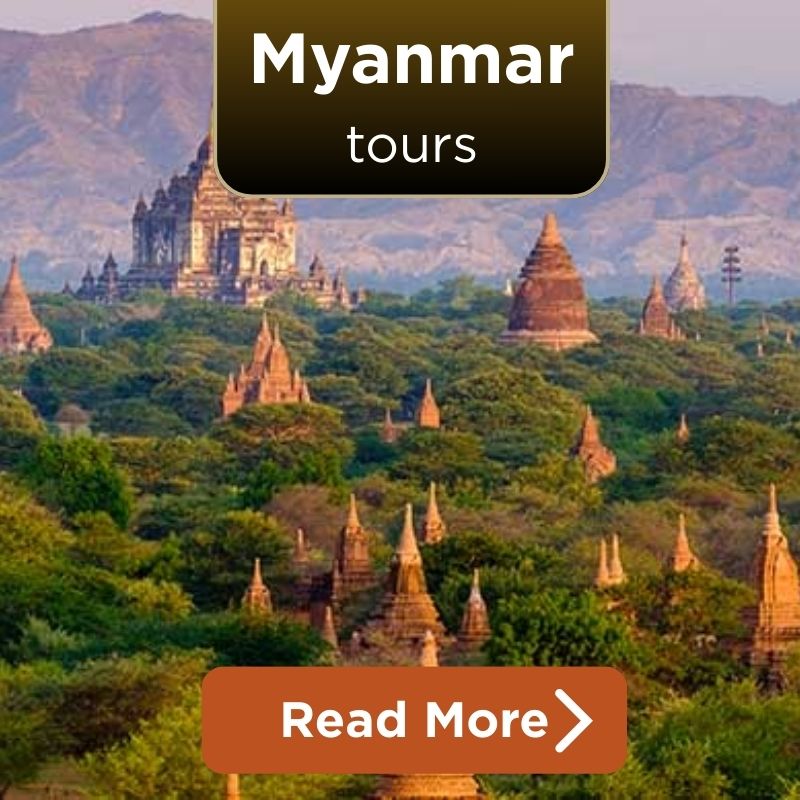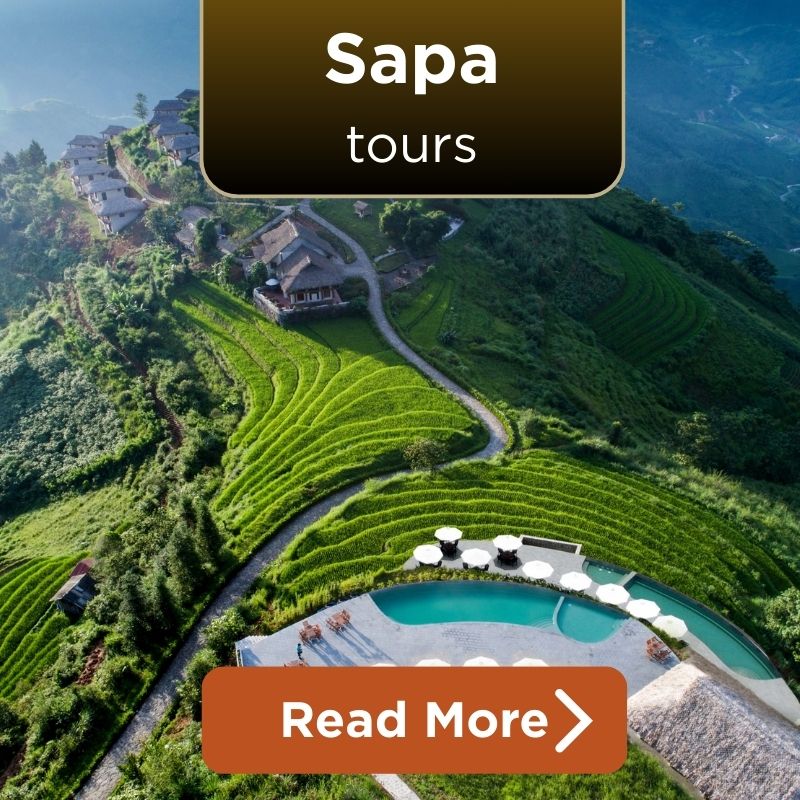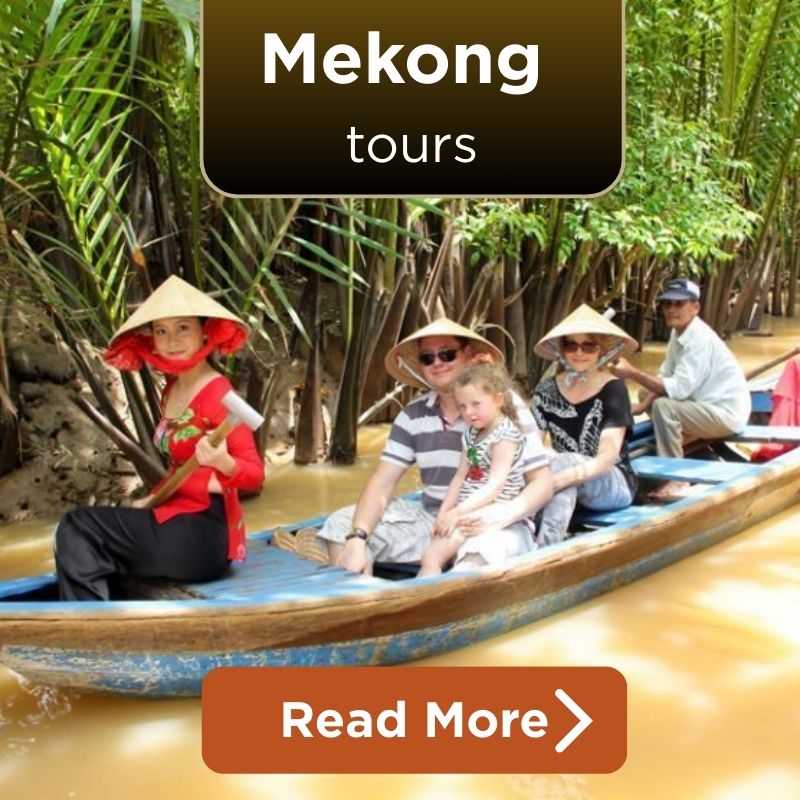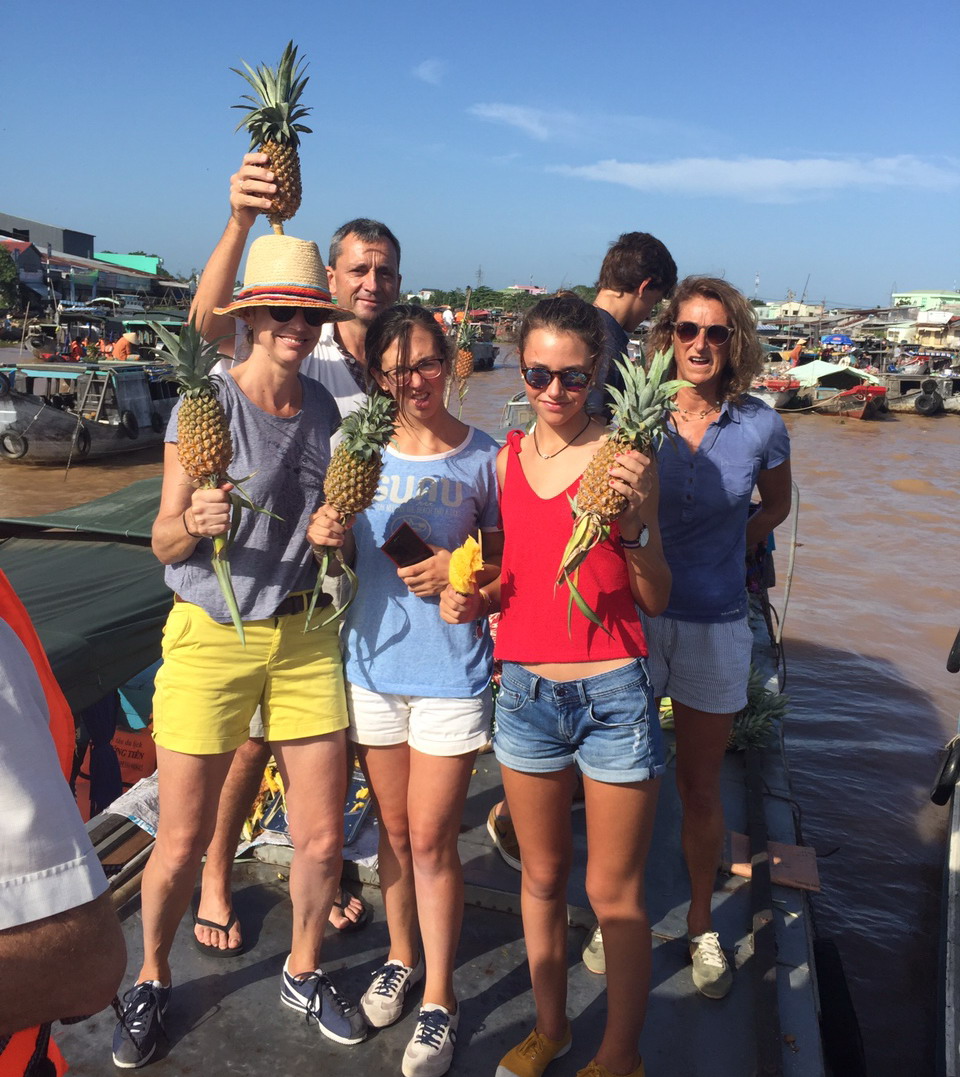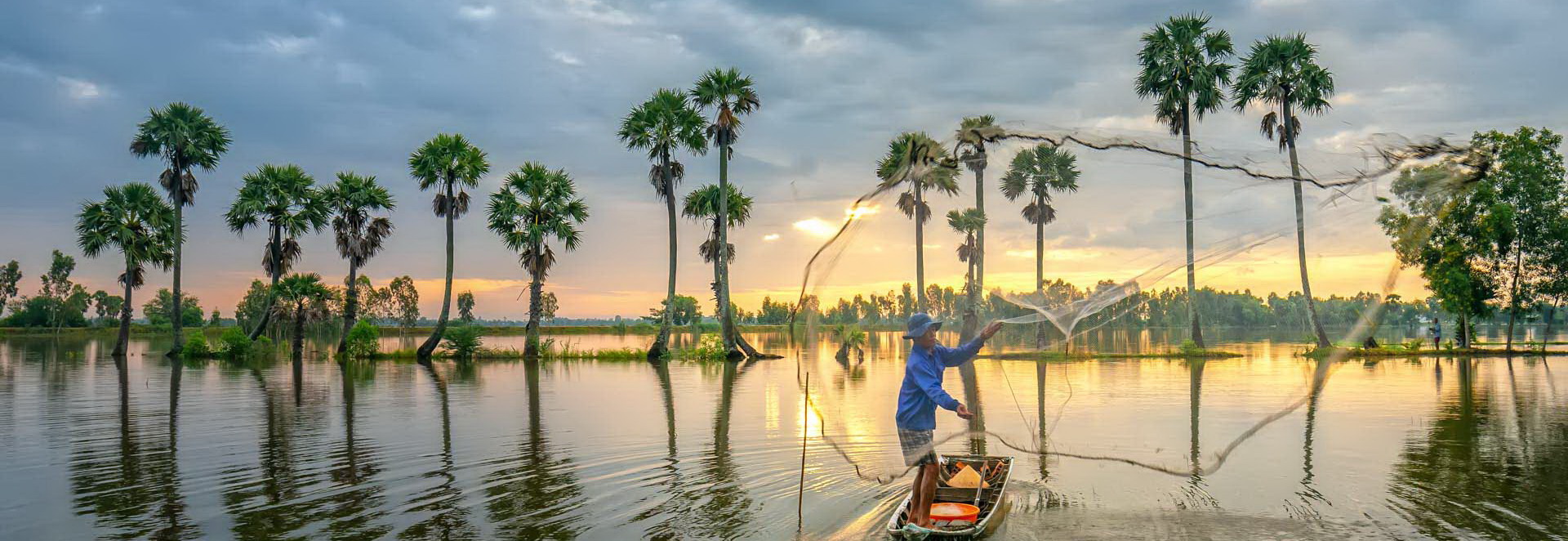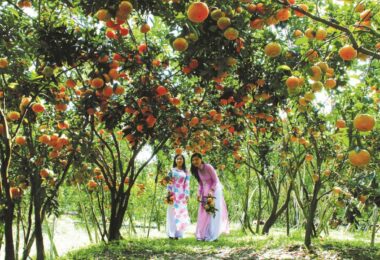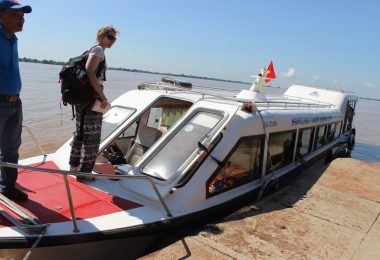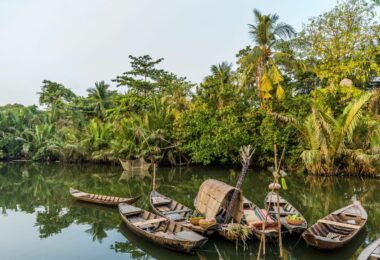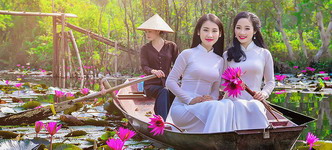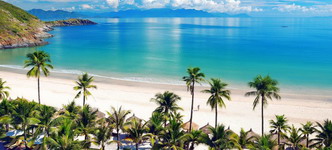Mekong River is not just one of many geographical points in Vietnam, it is a vital part of millions of people and a core landmark of Vietnam’s cultural and ecological wealth. The Mekong River in Vietnam is one of the world’s longest rivers, which spans across 4,350 kilometers through six other countries before it can finally meet the South China Sea in southern Vietnam, forming the Mekong Delta – the country’s core Rice Bowl. Over the years, the Mekong River has become the core of numerous expeditions and tourist attractions. In this article, we will overview why and what places are worth visiting within the Mekong River of Vietnam, reviewing its stunning landscapes, developed local life, destinations to drop by, adventures to try, and cuisine to taste. By the end of it, the reader will understand that this place is a must-visit for all tourists.
The Natural Beauty of the Mekong River

Mekong River in Vietnam
The Mekong River in Vietnam is one of the most picturesque and diverse pieces of land. Enriched with huge rice paddies, fruit farms, and misty mangroves, the river delta forms a mosaic of natural beauty. The ecosystem of the river mime of the richest in the world and features several wild species both flora and fauna. All-in-all, this fantastic combination of natural biodiversity makes Mekong one of the most appealing spots for a nature lover and a photographer.
Biodiversity and Scenic Beauty
Since the Mekong is known to be the major river in the delta, the biodiversity level there is stunning. Thousands of species of fish, birds, and plants are found only there, in Mekong delta. Among birds who frequent the delta are the extremely rare and gracious Sarus crane, huge and heavy gyps also known by the name of Indian vulture, and Bengal florican, but the list of unusual birds one can see at the delta is much longer. Overall, approximately 17 rare bird species that can be seen accidentally around the world call the delta their home. Moreover, the wetlands of the giant delta are home to nuclear fish, the strange and gloomy one that is pivotal for the entire fishing industry of the region.
Photography Opportunities
If one is a photographer, the Mekong Delta will blow his head with the diversity of forms and shades. In the early morning, the light is flattering, and the water is placid and clear mirroring everything around. The glow and colors of the Mekong floating markets deserve the best shot as well as the pre-sunset time when the light is supreme for taking pictures of the Mekong river. The elegance of millions of rice paddies that remind of nature’s lace biserial projection also will make a good picture.
Cultural Richness and Local Life
The Mekong River is not the only natural wonder in Vietnam but a cultural treasure. Most residents of the delta remain culturally linked despite the ongoing modernization. The delta has a diverse range of communities, each exhibiting distinctive ways that separate them from their neighbors. Bailey noted that the Mekong Delta’s variety of people and places contribute to the region’s vibrant cultural melange. From the bustling floating markets to the green and pristine countryside, the Mekong Delta is rich in cultural events.
Diverse Cultures and Communities
The Vietnamese, Khmer, and Chinese communities have settled in the Mekong Delta. Each community’s culture exists in the unique traditional lifestyle, architecture, religious festivals, and daily lives held by the residents. One is expected to encounter dance and theater plays performed while visiting interesting places such as Chua Vinh Trang, a beautiful old temple in the town of My Tho today, and take part in Vietnamese festivals. Some villages will also celebrate the Chinese Developed agriculture, particularly in the production of rice papers and fish sauces. You will pass by numerous Khmer monks, farmers, and children at work and admire the amazing women weaving on their homemade looms.
Traditional Lifestyles

Lifestyle along the Mekong River
The way of life along the Mekong River in Vietnam, like most places, is greatly influenced by the river. The river supports millions of people depending on fishing, farming and trading. Since the delta, will offer the first-hand side of seeing the life of these people to be along the river. Here you can see farmers in the fields, fishermen casting their nets and artisans busy making beautiful and luxurious handicrafts.
Local Crafts and Industries
Boat building, a main industry in Tra On and Can Tho, is evident. You also expect more people from Ba Tu made of coconut fibers. Ba Tu residents are adept in pottery, brick manufacturing, and mats making. There are the people of Rach Gia in the making of pestles, mortars, and betel cutting. Vam g in wood carving.
Key Cultural Festivals and Events
Culture-ridden festivals as well as other events make the delta fascinating to visit. Tet Nguyen Dan (Lunar New Year) is the most remarkable event and is marked with colorful schedules taking the whole of summer. Ok Om Bok is yet another culture of the Khmer residents during which program of the festival the moon is thanked for a good harvest.
Must-Visit Attractions
The Mekong River in Vietnam is home to a variety of attractions that are sure to entice any visitor. Here are some of the attractions of the life here.
Floating Markets

Floating Markets Cai Rang
The most iconic feature of the Mekong Delta is undoubtedly its floating markets. These markets, with the most popular being Cai Rang and Phong Dien, are vibrant and bustling trading posts, where goods are sold directly from the boats.
The Experience of Shopping and Dining on the Water
Visiting a floating market is a truly unique experience. Locals welcome you to the market, where you can visit endless boats selling all sorts of goods such as fresh fruits and flowers, groceries, etc. You can also grab a spot at a boat restaurant and start a tasting experience of local delights by the likes of pho and banh mi – all cooked right on the boats. These trips as well as time well spent with locals and immersion in their day to day lives.
Tips for Visiting and What to Expect
As a traveler, it is recommended to visit the floating market in the very morning where it is at its prime time. Locals can become your valuable guides as well, if you are brave enough, many are willing to share the trick of the trade and the basics of rowing. Besides, don’t forget your camera and comfortable water-proving shoes!
Fruit Orchards and Gardens
The fertile soil of the Mekong Delta is one of the perfect places to produce a wide range of fruits. Visiting the orchards and tasting the fruits there can be an exciting way to learn about the richness of the region. Popular fruits and the best time to visit
Popular Fruits and the Best Time to Visit
Mango, lychee, rambutan, and especially durian are popular tropical fruits in the Mekong Delta. Their different growth seasons on various plants make the place to be a must-see destination for tourists throughout the year. June, July, and August are the most promising months in the region when fruits are blossoming, and visitors are offered to taste even fresher fruits.
Recommended Orchards and Garden Tours
There are a lot of familiar orchards in the Mekong Delta, from which there are wonderful tours. The most popular of them are considered to be the Cai Be Fruit Orchard in Tien Giang and the Vinh Kim Fruit Orchard in My Tho. The fruit tastings mostly include drinking fresh juice, as well as mangos, and longans straight away from the tree.
Historical and Religious Sites
The Mekong Delta is full of historical and religious sites. Visiting these sites can give you a deepening insight into the area’s rich cultural history.
Important Temples and Pagodas
- Vinh Thang Pagoda: Located in My Tho, this is probably the most significant religious site in the delta. The temple surrounds a beautiful garden and is home to an exquisite blend of Vietnamese, Chinese and Khmer architectural styles.
- Other temples worth noting include Truc Lam Phuong Nam Zen Monastery in Can Tho and Doi Pagoda in Soc Trang.
Historical Landmarks and Their Significance
Ba Chuc Mausoleum is located in An Giang, this mass grave site is for hundreds of victims of the massacre carried out by the Kmer Rouge in 1978. If you think visiting these locations can help you understand the history behind the landmarks, you will have a deeper look. The experience is much richer and more meaningful when participating in guided tours.
Suggestions for Guided Tours to Enhance the Experience
Guided tours can be a great way to learn more about the historical and cultural significance of the sites. It is especially useful to do while visiting a temple or an ancient site, where a knowledgeable person can provide you with detailed explanations and bring the site’s history to life.
Adventure and Ecotourism

Indian vulture
The Mekong River in Vietnam offers a wide range of eco-tourism opportunities to those interested in nature, wildlife and adventures. The natural element of water offers chances for boating, while the wildlife can best be connected by taking part in kayaking, trekking, or biking in the mangrove forests of the Mekong Delta.
Opportunities for Eco-Tours and Nature Excursions
Eco-tours in the Mekong Delta offer an opportunity to explore the area’s natural resources while following some principles of sustainable tourism. It might involve various activities, such as kayaking, cycling, or trekking in the countryside. Tra Su Cajuput Forest in An Giang is one of the best places to go for an eco tour, as it offers some of the most stunning views of the area and has many endemic bird species that can be found in the area. The surrounding water bodies allow for a boat trip, which gets further enhanced by the waters peppered with water lilies and lotus
Activities like Boating, Bird Watching, and Exploring Mangrove Forests
The Mekong Delta is an exceptionally watery region and taking a boat out at some point of your visit is compulsory. Whether is it on the river or in one of the many narrow canals, floating through the maze of the delta’s waterways and canals is an amazing experience. It will allow guests to appreciate the view of various bird species which can be often seen in bird sanctuaries in the region. Finally, exploring the delta’s reserves of mangrove forest in Can Gio is another way to get acquainted with its unique biodiversity.

Explore the mangrove forest
Sustainable Tourism Practices in the Mekong Delta
It is necessary to consider other criteria to ensure that the nature and culture of the Mekong Delta are preserved too. Fortunately, many tour operators share this vision, so they are working with the communities, are not harming the environment, and try to protect the wildlife, according to Moyer and Font, while also several other reports mention that many visitors decide to book one of such tours as well.
Highlighting National Parks and Protected Areas
As for the natural sites of the Mekong Delta, it would be worth mentioning several examples of national parks and protected areas. All these measures aimed at ensuring a better future for the flora and fauna make them worth visiting. In particular, one could mention Tram Chim National Park located in Dong Thap and famous for its wetlands and the world’s greatest bird variety as well as U Minh Thuong National Park found in Kien Giang among mangroves.
Culinary Delights of the Mekong Delta
Vietnam’s Mekong River is a picturesque place to visit, and no journey would be meaningful without experiencing its culinary wonders. As a region with many diverse cultures, the Mekong Delta has a wide variety of dishes based on the region’s plentiful natural resources. Foods in the wet delta are fresh, flavorful and properly cooked.
Introduction to Mekong Delta Cuisine

Thin pancakes
Mekong Delta’s food is unique in terms of its freshness of ingredients, richness of flavors, and some specific ways of cooking them. Many of the region’s signature dishes incorporate fish and seafood which are rather important components of the local diet as the delta is watered by a whole river. Green herbs, fruits and vegetables picked from the delta’s fertile soil are also vital ingredients in many recipes.
Must-Try Dishes and Local Specialties
Some dishes are worth a try if visitors come to the Mekong Delta. One of the most delicious is a savory pancake called Banh Xeo with shrimp, pork, and bean sprouts in it. Noodle soup called Hu Tieu has a clear and tasty broth and is quite popular. If you want to sample a special dish the region is proud of, you should try a caramelized fish called Ca Kho To which is cooked in a clay pot. It is both tasty and gives an impression of the region’s culinary heritage.
Street Food and Market Experiences
One of the most interesting activities that can be partaken of in the Mekong Delta is strolling through the delta’s streets and markets and sampling the delights they offer. Night markets are especially attractive and give tourists ample opportunities to taste the food. The range of dishes is wide, yet over some of the simpler, do not pass by banh mi – a Vietnamese sandwich with meat, cilantro, cucumber, and sometimes other vegetables and herbs. Che is another must try food as it is a sweet soup made of coconut milk and dozens of sweet beans, fruits, and lotus seeds. The dishes and markets are too vibrant and pungent to resist.
Recommendations for Local Restaurants and Eateries
Although there are several worthy places to eat in the delta, there are some which can boast of the best service. Among them is Nam Bo Restaurant in Can Tho which is famous for its traditional Vietnamese foods and stunning river views. Mekong Taste in My Tho is also very popular due to its relatively succulent seafood and polite attendants. All in all, the restaurants offer a wonderful chance to experience the authentic taste of the delta.
Best Time to Visit the Mekong Delta
Overview of the Climate and Seasons in the Mekong Delta
The climate in the Mekong Delta is tropical monsoon, which is characterized by the wet and dry seasons. Precisely, the wet season in this area occurs between May or June and October or November, while the dry season covers November or December to April. However, it is important to note that the temperatures are invariably hot and usually range from 25 to 35°C (77 to 95°F) in both seasons. As this delta experiences two main seasons, the best time can differ depending upon the character of the visit.
Best Months for Various Activities and Experiences
When to visit the Mekong Delta depends on what you want to do during your visit. Sightseeing, boat tours, and exploration of the outdoor attractions in the area can be the individual must-do in the dry season. The best time to see fruit orchards is in the wet season, especially June to August, as it is when the fruit ripens. Besides, this time of the year also sees the floating markets at their best.
Tips for Avoiding the Rainy Season and Making the Most of Your Visit
The best time to avoid the wet season is from December to April. This period sees the most hours of sunlight and rain is minimal. However, even the wet season does not present a significant challenge to the visitor’s plans as the rains are usually short-lived and may work as a relief from the heat. Therefore, come with light clothes, sunscreen, and insect repellent every time you visit the Mekong.
Conclusion
The Mekong River in Vietnam is a place where you can find beautiful nature, rich culture, and unforgettable adventures called tours. Do you want to explore the overwhelming landscapes and local life? Visit the marvelous must-go places in the Delta and eat the most delicious dishes in your life. Keep on reading, and you will discover the best time to visit, useful tips, and the importance of sustainability.
When planning your holiday to the Mekong River in Vietnam, keep in mind that it is not only about traveling somewhere but depending about how people live near the river. Pick up your luggage, go on a trip, and understand why the Mekong Delta is thought to be a must-go destination for people around. Don’t forget to regularly follow our Fanpage for more interesting information about traveling Mekong to and to book Mekong Tours at the best prices.









